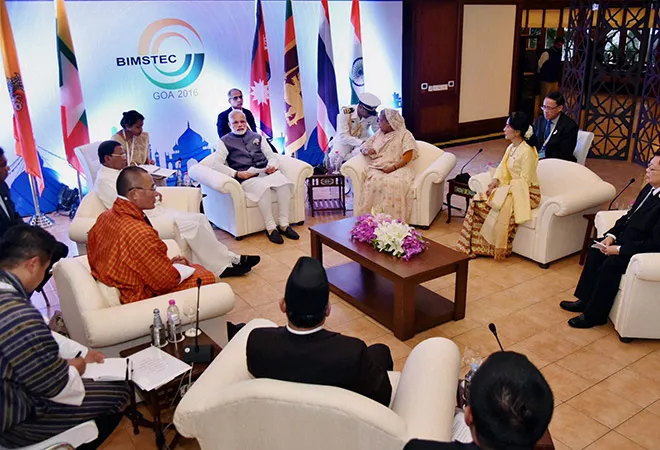-
CENTRES
Progammes & Centres
Location
BIMSTEC is the only forum that brings together India’s strategic peripheries — South, East and North — under one single grouping.
 This article is published in collaboration with Nepal Institute for International Cooperation and Engagement (NIICE). To read the Nepali version, click here.
This article is published in collaboration with Nepal Institute for International Cooperation and Engagement (NIICE). To read the Nepali version, click here.
Delhi’s initiative of a regional response in the wake of the COVID-19 pandemic generated a discussion on why Delhi activated the South Asian Association for Regional Cooperation (SAARC) and not the Bay of Bengal Initiative for Multi-Sectoral Technical Economic Cooperation (BIMSTEC), a grouping Delhi has been prioritising in recent years. Some asked if there was a rethink in Delhi’s approach. Though a closer look at Delhi’s SAARC diplomacy in combating the global pandemic indicates that the move was driven by geographical factor and Delhi’s view of its regional role and not so much about its approach towards regional/subregional groupings.
This can be understood by examining Delhi’s changing approach towards region-building as a rising power. Taking leadership role in region-building is at the root of India’s current regional approach on the recognition that it is in its own interests. Regional/subregional mechanisms are viewed as platforms to engage with the neighbourhood and to meet its aspirations as a rising power. Recently, External Affairs Minister S. Jaishankar made the link between regionalism and India’s rise more clearly when he said economic diplomacy in neighbourhood policy “creates a large sense of regionalism that is key to
The roots of the new regional approach could be traced back to the “Gujral Doctrine” that essentially sought to accommodate India’s smaller neighbours with good faith and trust without seeking reciprocity. By the turn of century, the stakes for Delhi to recalibrate its regional policy became even more urgent owing to developments both within the country as well as in the neighbourhood having serious implications on India’s regional interests. Two strategic factors have significantly shaped India’s new regional approach. To sustain the new economic growth trajectory, it was imperative that ensure regional instability does not hamper India’s interests. The other factor was China’s growing footprints in the neighbourhood and the concern of losing its influence to China grew in Delhi’s regional calculations.
The reorientation of India’s regional approach that began in the early 1990s, particularly with the launch of the Look East policy followed by the Gujral Doctrine, took strategic dimensions in the mid-2000s. As part of the new approach, there was recognition of deep interdependence in the security realm with the neighbourhood that India cannot insulate itself. This prompted Delhi to reframe its regional security approach that allowed it to take regional leadership role in regional/subregional security initiatives in collaboration with neighbours with the aim to ensure security and stability in the region.
If the Gujral Doctrine emphasised the need for Delhi to be generous to its smaller neighbours, the Manmohan Singh regime stressed the idea of sharing India’s prosperity with its neighbours with the hope that it would help minimise instability in the neighbourhood that would adversely affect its growth. Taking the new regional approach forward in building an integrated neighbourhood, in 2007 India announced that as the largest country in SAARC it would open its market to the Least Developed Countries without insisting on reciprocity and further reduce the sensitive list in respect of these countries.
A paradox of India’s rise is that its role in regional governance has long remains locked in regional geopolitics. The failure of the SAARC regional framework, despite in existence of for decades, limited India’s region-building ability. With the regional grouping SAARC making little headway, the idea of sub-regionalism to push forward regionalism become the prime driver of India’s neighbourhood approach. This could be seen both in the economic field as well as in the security domain. India strengthened its engagements with subregional groupings including the BIMSTEC.
In the mid-2000s, the Bay of Bengal subregional forum was expanded to include Nepal and Bhutan and later decision to set up a permanent secretariat in Dhaka was finalised at the third BIMSTEC Summit in 2011. India also began to push for physical connectivity with its neighbours both to reintegrate the region. The strategic salience of the BIMSTEC for India can be ascertained when seen through India’s sub-regions. The BIMSTEC connects three important sub-regions of India — Nepal and Bhutan in the Himalayan sub-region; Sri Lanka and Bangladesh in the Bay of Bengal sub-region; and Myanmar and Thailand in the Mekong sub-region. In this sense, BIMSTEC is the only forum that brings together India’s strategic peripheries (South, East and North) under one single grouping.
BIMSTEC is at the centre of Delhi’s engagements with other various regional and sub-regional groupings in India’s eastern neighbourhood with its members often are also members of other regional and sub-regional groupings in their respective regions and sub-regions. For instance, Myanmar and Thailand are members of ASEAN and Greater Mekong Subregion (GMS), while Bangladesh, Bhutan and Nepal are members of SAARC and Bangladesh-Bhutan-India-Nepal (BBIN) Initiative. Bangladesh and Myanmar are also members of the four-member sub-regional BCIM (Bangladesh, China, India, Myanmar) forum along with India and China. The progress of BIMSTEC, therefore, could help regional integration of the entire north-eastern Indian Ocean region with the Bay of Bengal at the centre.
There is a tendency to view BIMSTEC subregionalism as Delhi’s alternative to the SAARC framework and that India is pushing forward BIMSTEC because Pakistan is not a member of the subregional grouping. However, as the above discussion suggests, such a view may be narrow and would not fully capture India’s evolving regional approach. Delhi’s interests in regional/subregional initiatives including BIMSTEC are driven not by the Pakistan factor but by the opportunities and challenges that subregional dynamics presents to India.
At the same time, sharing close historical, cultural, and geographical ties with the SAARC member-states, the region is critical for India’s internal stability and development. As the recent diplomatic move suggests, Delhi wants the SAARC project work in areas of mutual interests and fighting common challenges such as the current global pandemic. As Prime Minister Narendra Modi said during the video-conference with SAARC leaders on combating the COVID-19: “Our people-to-people ties are ancient, and our societies are deeply inter-connected. Therefore, we must all prepare together, we must all act together, and we must all succeed together.”
The views expressed above belong to the author(s). ORF research and analyses now available on Telegram! Click here to access our curated content — blogs, longforms and interviews.

K. Yhome was Senior Fellow with ORFs Neighbourhood Regional Studies Initiative. His research interests include Indias regional diplomacy regional and sub-regionalism in South and Southeast ...
Read More +